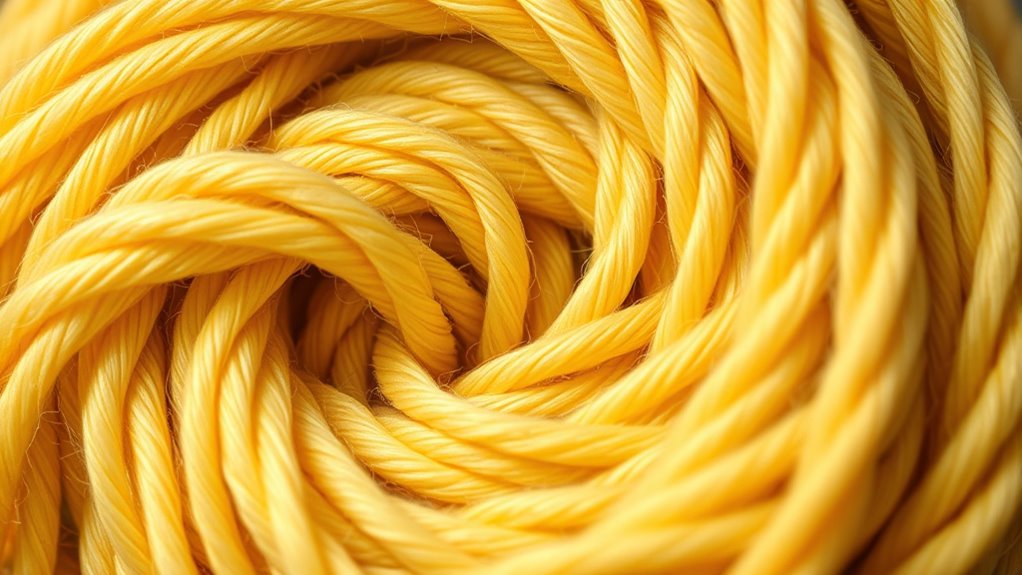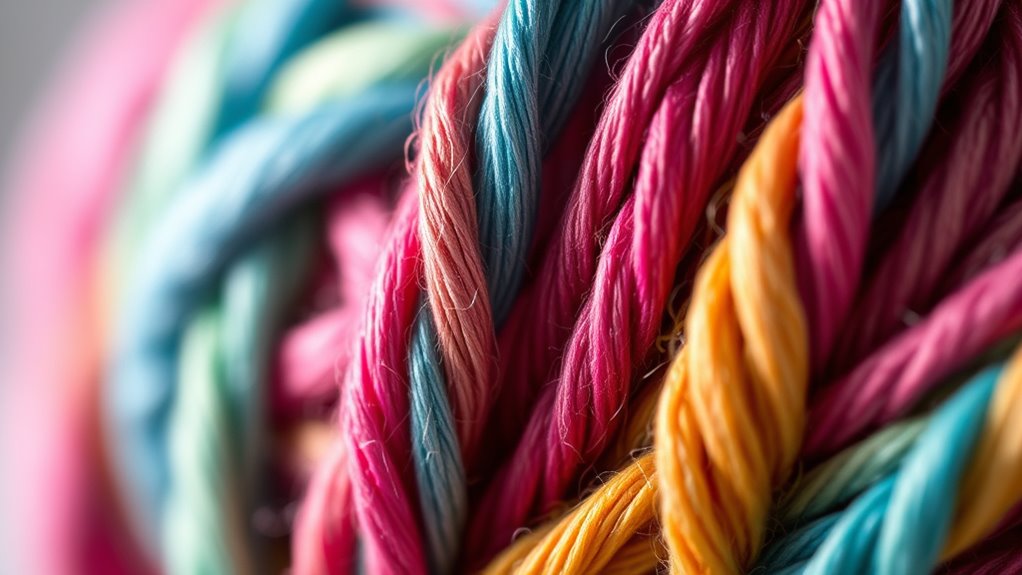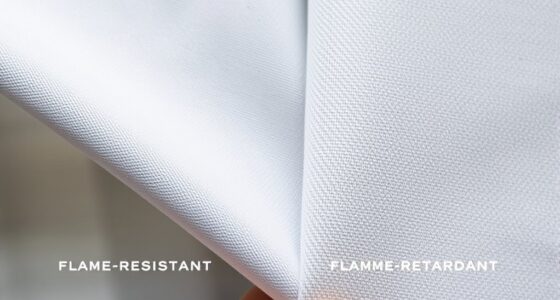Yarn twist directly affects how durable your yarn will be. When the twist is tight, it helps fibers stay anchored and resist unraveling, snagging, and breaking over time. Looser twist provides softness and flexibility but less shape retention and wear resistance. Proper twist balances strength and flexibility, making your projects last longer. If you want to understand how to choose the best yarn for durability, keep exploring these key factors.
Key Takeaways
- Higher twist in yarn generally indicates greater resistance to unraveling and snagging, enhancing durability.
- Too little twist makes yarn softer but less resilient, increasing risk of shape loss and wear over time.
- Properly twisted yarn balances strength and flexibility, leading to longer-lasting finished projects.
- Excessive twist can make yarn stiff, reducing comfort but increasing tension resistance.
- The right amount of twist depends on the fiber type and intended use, directly influencing the yarn’s durability.

Have you ever wondered why some yarns hold their shape better than others? The answer often comes down to the fiber strength and the manufacturing process behind the yarn. When you look at a yarn, its twist can tell you a lot about how durable it will be over time. Yarn twist refers to how tightly the fibers are spun together, and this directly impacts its resilience and longevity. Stronger fibers naturally withstand tension and wear better, but the way they’re spun also plays a vital role. A well-executed manufacturing process ensures that the fibers are twisted just enough to balance strength and flexibility, preventing the yarn from unraveling or losing its shape prematurely.
Yarn durability depends on fiber strength and precise manufacturing twist for lasting quality
The manufacturing process determines how well the fibers are aligned and anchored within the yarn. High-quality production techniques involve carefully controlling the twist, which enhances fiber cohesion. When fibers are spun with ideal tension, the yarn becomes more resistant to stretching, snagging, or breaking. This process also affects the overall fiber strength—the inherent ability of the fibers to resist breaking under stress. Stronger fibers, such as certain types of wool, cotton, or synthetic materials, naturally produce more durable yarns. But even with strong fibers, if the manufacturing process is sloppy or inconsistent, the yarn will not perform well in the long run.
The amount of twist in the yarn influences its durability markedly. A tightly twisted yarn tends to be more resistant to unwinding and snagging, making it suitable for items that endure frequent use or washing. Conversely, a loosely twisted yarn may feel softer and more flexible, but it might not hold its shape as well or last as long. You should consider both the fiber strength and the manufacturing process when choosing yarn for your projects. Stronger fibers combined with a precise twisting technique result in a yarn that maintains its shape, resists wear, and withstands the test of time.
Ultimately, the durability of your yarn depends on how well these factors come together. Understanding the link between fiber strength and manufacturing process helps you make better choices, whether you’re knitting, crocheting, or weaving. When you select yarn with the right twist, you’re not just picking a material that looks good—you’re choosing a product designed to last. Paying attention to these details ensures your finished project stays beautiful and functional longer, giving you more value and satisfaction from your craft.
Frequently Asked Questions
How Does Yarn Twist Affect Comfort?
Yarn twist impacts your comfort by influencing fiber softness and moisture absorption. A lower twist creates a softer feel, making garments gentle against your skin, while a higher twist can make fabrics stiffer. When twist is ideal, fibers maintain their softness and absorb moisture better, keeping you comfortable and dry. So, the right twist level ensures your clothing feels pleasant and functional, enhancing your overall wearing experience.
Can Yarn Twist Influence Color Retention?
Yarn twist can influence color retention by affecting dye absorption. Higher twist yarns tend to hold dye more tightly, leading to less color fading over time. Conversely, lower twist yarns might absorb dye unevenly, which can cause colors to fade faster with washing and wear. So, if you’re after vibrant, long-lasting colors, choosing a yarn with the right twist helps guarantee your fabrics stay bright longer.
What Is the Ideal Twist for Different Fibers?
You need to match the yarn twist to each fiber’s strength for ideal durability. For stronger fibers like nylon, a higher twist enhances durability, while delicate fibers like silk need a lower twist to prevent damage. Focus on twist uniformity to guarantee consistent performance and appearance. Adjust twist levels based on fiber properties, balancing strength and flexibility to create a resilient, high-quality yarn suited for your project.
Does Higher Twist Mean Easier to Maintain?
Higher twist yarns often seem more durable, but they don’t necessarily make maintenance easier. Increased twist can improve twist durability, making the fabric more resistant to wear and tear. However, it can also make the yarn stiffer, which might complicate care and reduce softness. So, while higher twist can enhance durability, it doesn’t always translate to easier maintenance—consider the fiber and fabric use to find the best balance.
How Does Twist Impact Machine Knitting?
When you consider how twist impacts machine knitting, focus on twist consistency and fiber compatibility. A consistent twist ensures your machine runs smoothly, reducing snags and uneven stitches. Proper fiber compatibility means the yarn can handle the twist without breaking or tangling. You’ll find that balanced twist improves your knitting process, making it more efficient and producing a uniform, durable fabric. Keep these factors in mind for ideal machine knitting results.
Conclusion
Understanding yarn twist helps you choose fabrics that last. While some might think higher twist always means more durability, that’s not the whole story—you also need to take into account fiber type and manufacturing. By paying attention to twist, you can select textiles that withstand daily wear without sacrificing softness. So, next time you’re shopping, remember: a well-balanced twist ensures your garments stay comfortable and durable, proving that a little knowledge truly goes a long way in making smarter choices.










